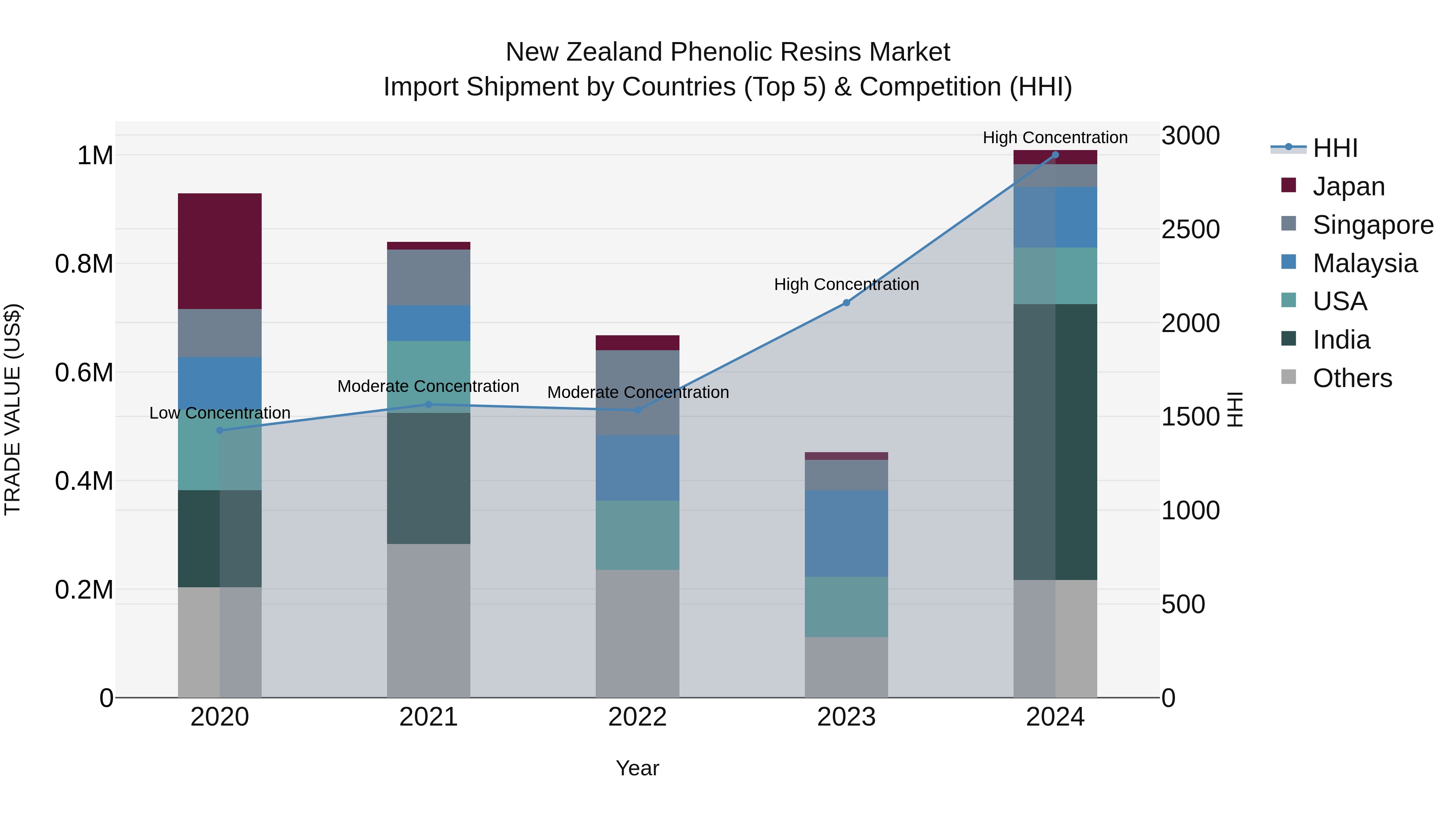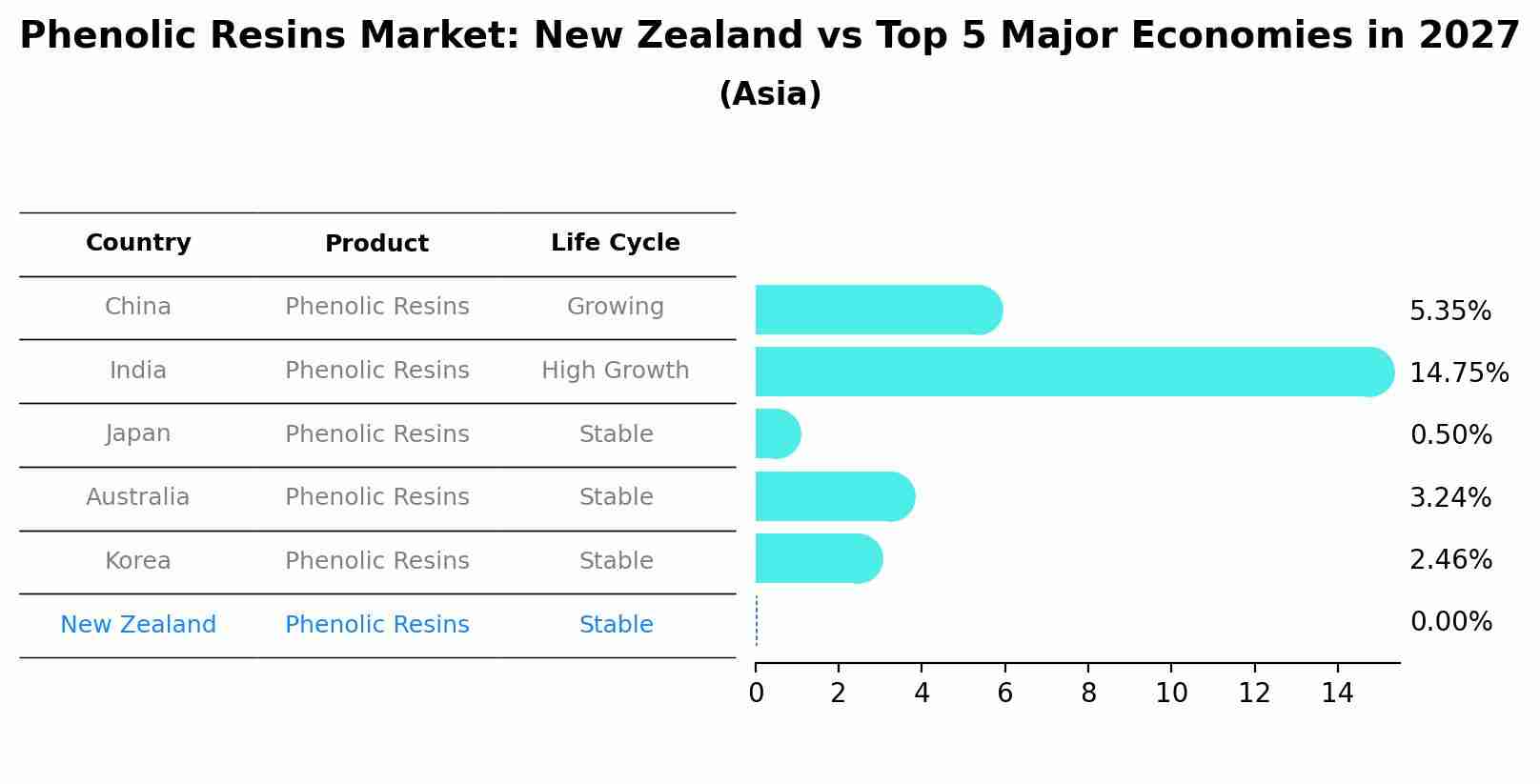New Zealand Phenolic Resins Market (2025-2031) | Size, Share, Segmentation, Industry, Companies, Analysis, Value, Revenue, Growth, Outlook, Forecast & Trends
| Product Code: ETC4679417 | Publication Date: Nov 2023 | Updated Date: Nov 2025 | Product Type: Market Research Report | |
| Publisher: 6Wresearch | Author: Shubham Deep | No. of Pages: 60 | No. of Figures: 30 | No. of Tables: 5 |
New Zealand Phenolic Resins Market Top 5 Importing Countries and Market Competition (HHI) Analysis
The New Zealand phenolic resins import market in 2024 continued to witness significant concentration with top exporters being India, Malaysia, USA, Australia, and Germany. The high Herfindahl-Hirschman Index (HHI) indicates a concentrated market structure. The compound annual growth rate (CAGR) from 2020 to 2024 stood at 2.07%, showcasing steady expansion. Notably, the growth rate surged in 2024 by 123.16%, indicating a robust uptrend in import shipments. This data suggests a dynamic and competitive landscape for phenolic resins imports in New Zealand, driven by key exporting countries.

Phenolic Resins Market: New Zealand vs Top 5 Major Economies in 2027 (Asia)
New Zealand's Phenolic Resins market is anticipated to experience a stable growth rate of 0.00% by 2027, reflecting trends observed in the largest economy China, followed by India, Japan, Australia and South Korea.

New Zealand Phenolic Resins Market Overview
The New Zealand phenolic resins market is witnessing steady growth driven by their diverse applications across industries such as automotive, construction, and electronics. Phenolic resins, derived from phenol and formaldehyde, are valued for their heat resistance, mechanical strength, and flame-retardant properties. In the automotive industry, phenolic resins are used in brake and clutch components, gaskets, and insulating materials. Additionally, their applications in laminates, coatings, and adhesives contribute to market demand. However, concerns regarding formaldehyde emissions and regulatory restrictions pose challenges to market growth, prompting efforts towards alternative formulations
Drivers of the market
In New Zealand, the Phenolic Resins market is driven by the expanding construction industry, particularly in the infrastructure and building sectors. Phenolic resins find extensive applications in manufacturing laminates, adhesives, and molding compounds, which are essential components in construction materials. Moreover, the growing automotive sector and increasing demand for fire-resistant materials further propel the market growth.
Challenges of the market
The phenolic resins market in New Zealand faces challenges including fluctuations in raw material prices, which can affect production costs and profitability. Environmental regulations and safety concerns necessitate investments in safe production methods and alternative resins. The market is also impacted by competition from other synthetic and natural resins, which can offer similar properties at lower prices. Additionally, the need for continuous innovation to meet changing industrial requirements adds to the market`s challenges.
Government Policy of the market
Government policies in the phenolic resins market may encompass chemical safety regulations, emissions standards, and industrial hygiene guidelines. Policies aim to promote safe production practices, minimize environmental impacts, and protect worker health in facilities manufacturing phenolic resins for adhesives, coatings, and composite materials.
Key Highlights of the Report:
- New Zealand Phenolic Resins Market Outlook
- Market Size of New Zealand Phenolic Resins Market, 2024
- Forecast of New Zealand Phenolic Resins Market, 2031
- Historical Data and Forecast of New Zealand Phenolic Resins Revenues & Volume for the Period 2021-2031
- New Zealand Phenolic Resins Market Trend Evolution
- New Zealand Phenolic Resins Market Drivers and Challenges
- New Zealand Phenolic Resins Price Trends
- New Zealand Phenolic Resins Porter`s Five Forces
- New Zealand Phenolic Resins Industry Life Cycle
- Historical Data and Forecast of New Zealand Phenolic Resins Market Revenues & Volume By Product for the Period 2021-2031
- Historical Data and Forecast of New Zealand Phenolic Resins Market Revenues & Volume By Novolac for the Period 2021-2031
- Historical Data and Forecast of New Zealand Phenolic Resins Market Revenues & Volume By Resol for the Period 2021-2031
- Historical Data and Forecast of New Zealand Phenolic Resins Market Revenues & Volume By Others for the Period 2021-2031
- Historical Data and Forecast of New Zealand Phenolic Resins Market Revenues & Volume By Application for the Period 2021-2031
- Historical Data and Forecast of New Zealand Phenolic Resins Market Revenues & Volume By Wood Adhesives for the Period 2021-2031
- Historical Data and Forecast of New Zealand Phenolic Resins Market Revenues & Volume By Molding for the Period 2021-2031
- Historical Data and Forecast of New Zealand Phenolic Resins Market Revenues & Volume By Insulation for the Period 2021-2031
- Historical Data and Forecast of New Zealand Phenolic Resins Market Revenues & Volume By Laminates for the Period 2021-2031
- Historical Data and Forecast of New Zealand Phenolic Resins Market Revenues & Volume By Paper Impregnation for the Period 2021-2031
- Historical Data and Forecast of New Zealand Phenolic Resins Market Revenues & Volume By Coatings for the Period 2021-2031
- Historical Data and Forecast of New Zealand Phenolic Resins Market Revenues & Volume By Others for the Period 2021-2031
- New Zealand Phenolic Resins Import Export Trade Statistics
- Market Opportunity Assessment By Product
- Market Opportunity Assessment By Application
- New Zealand Phenolic Resins Top Companies Market Share
- New Zealand Phenolic Resins Competitive Benchmarking By Technical and Operational Parameters
- New Zealand Phenolic Resins Company Profiles
- New Zealand Phenolic Resins Key Strategic Recommendations
Frequently Asked Questions About the Market Study (FAQs):
1 Executive Summary |
2 Introduction |
2.1 Key Highlights of the Report |
2.2 Report Description |
2.3 Market Scope & Segmentation |
2.4 Research Methodology |
2.5 Assumptions |
3 New Zealand Phenolic Resins Market Overview |
3.1 New Zealand Country Macro Economic Indicators |
3.2 New Zealand Phenolic Resins Market Revenues & Volume, 2021 & 2031F |
3.3 New Zealand Phenolic Resins Market - Industry Life Cycle |
3.4 New Zealand Phenolic Resins Market - Porter's Five Forces |
3.5 New Zealand Phenolic Resins Market Revenues & Volume Share, By Product, 2021 & 2031F |
3.6 New Zealand Phenolic Resins Market Revenues & Volume Share, By Application, 2021 & 2031F |
4 New Zealand Phenolic Resins Market Dynamics |
4.1 Impact Analysis |
4.2 Market Drivers |
4.2.1 Increasing demand for phenolic resins in the construction industry for applications such as adhesives, insulation materials, and laminates. |
4.2.2 Growing use of phenolic resins in the automotive sector for manufacturing lightweight components. |
4.2.3 Rising awareness about the benefits of phenolic resins, such as high heat resistance and durability. |
4.3 Market Restraints |
4.3.1 Fluctuating raw material prices, such as formaldehyde and phenol, impacting production costs. |
4.3.2 Stringent environmental regulations related to the use and disposal of phenolic resins, leading to compliance challenges. |
4.3.3 Competition from alternative materials like epoxy resins and polyurethanes affecting market penetration. |
5 New Zealand Phenolic Resins Market Trends |
6 New Zealand Phenolic Resins Market Segmentations |
6.1 New Zealand Phenolic Resins Market, By Product |
6.1.1 Overview and Analysis |
6.1.2 New Zealand Phenolic Resins Market Revenues & Volume, By Novolac, 2021-2031F |
6.1.3 New Zealand Phenolic Resins Market Revenues & Volume, By Resol, 2021-2031F |
6.1.4 New Zealand Phenolic Resins Market Revenues & Volume, By Others, 2021-2031F |
6.2 New Zealand Phenolic Resins Market, By Application |
6.2.1 Overview and Analysis |
6.2.2 New Zealand Phenolic Resins Market Revenues & Volume, By Wood Adhesives, 2021-2031F |
6.2.3 New Zealand Phenolic Resins Market Revenues & Volume, By Molding, 2021-2031F |
6.2.4 New Zealand Phenolic Resins Market Revenues & Volume, By Insulation, 2021-2031F |
6.2.5 New Zealand Phenolic Resins Market Revenues & Volume, By Laminates, 2021-2031F |
6.2.6 New Zealand Phenolic Resins Market Revenues & Volume, By Paper Impregnation, 2021-2031F |
6.2.7 New Zealand Phenolic Resins Market Revenues & Volume, By Coatings, 2021-2031F |
7 New Zealand Phenolic Resins Market Import-Export Trade Statistics |
7.1 New Zealand Phenolic Resins Market Export to Major Countries |
7.2 New Zealand Phenolic Resins Market Imports from Major Countries |
8 New Zealand Phenolic Resins Market Key Performance Indicators |
8.1 Research and development investment in creating innovative phenolic resin formulations. |
8.2 Number of patents filed for new phenolic resin technologies. |
8.3 Adoption rate of sustainable practices in phenolic resin production processes. |
8.4 Level of investment in expanding production capacities for phenolic resins. |
9 New Zealand Phenolic Resins Market - Opportunity Assessment |
9.1 New Zealand Phenolic Resins Market Opportunity Assessment, By Product, 2021 & 2031F |
9.2 New Zealand Phenolic Resins Market Opportunity Assessment, By Application, 2021 & 2031F |
10 New Zealand Phenolic Resins Market - Competitive Landscape |
10.1 New Zealand Phenolic Resins Market Revenue Share, By Companies, 2024 |
10.2 New Zealand Phenolic Resins Market Competitive Benchmarking, By Operating and Technical Parameters |
11 Company Profiles |
12 Recommendations | 13 Disclaimer |
- Single User License$ 1,995
- Department License$ 2,400
- Site License$ 3,120
- Global License$ 3,795
Search
Thought Leadership and Analyst Meet
Our Clients
Related Reports
- Germany Breakfast Food Market (2026-2032) | Industry, Share, Growth, Size, Companies, Value, Analysis, Revenue, Trends, Forecast & Outlook
- Australia Briquette Market (2025-2031) | Growth, Size, Revenue, Forecast, Analysis, Trends, Value, Share, Industry & Companies
- Vietnam System Integrator Market (2025-2031) | Size, Companies, Analysis, Industry, Value, Forecast, Growth, Trends, Revenue & Share
- ASEAN and Thailand Brain Health Supplements Market (2025-2031) | Strategy, Consumer Insights, Analysis, Investment Trends, Opportunities, Growth, Size, Share, Industry, Revenue, Segments, Value, Segmentation, Supply, Forecast, Restraints, Outlook, Competition, Drivers, Trends, Demand, Pricing Analysis, Competitive, Strategic Insights, Companies, Challenges
- ASEAN Bearings Market (2025-2031) | Strategy, Consumer Insights, Analysis, Investment Trends, Opportunities, Growth, Size, Share, Industry, Revenue, Segments, Value, Segmentation, Supply, Forecast, Restraints, Outlook, Competition, Drivers, Trends, Demand, Pricing Analysis, Competitive, Strategic Insights, Companies, Challenges
- Europe Flooring Market (2025-2031) | Outlook, Share, Industry, Trends, Forecast, Companies, Revenue, Size, Analysis, Growth & Value
- Saudi Arabia Manlift Market (2025-2031) | Outlook, Size, Growth, Trends, Companies, Industry, Revenue, Value, Share, Forecast & Analysis
- Uganda Excavator, Crane, and Wheel Loaders Market (2025-2031) | Strategy, Consumer Insights, Analysis, Investment Trends, Opportunities, Growth, Size, Share, Industry, Revenue, Segments, Value, Segmentation, Supply, Forecast, Restraints, Outlook, Competition, Drivers, Trends, Demand, Pricing Analysis, Competitive, Strategic Insights, Companies, Challenges
- Rwanda Excavator, Crane, and Wheel Loaders Market (2025-2031) | Strategy, Consumer Insights, Analysis, Investment Trends, Opportunities, Growth, Size, Share, Industry, Revenue, Segments, Value, Segmentation, Supply, Forecast, Restraints, Outlook, Competition, Drivers, Trends, Demand, Pricing Analysis, Competitive, Strategic Insights, Companies, Challenges
- Kenya Excavator, Crane, and Wheel Loaders Market (2025-2031) | Strategy, Consumer Insights, Analysis, Investment Trends, Opportunities, Growth, Size, Share, Industry, Revenue, Segments, Value, Segmentation, Supply, Forecast, Restraints, Outlook, Competition, Drivers, Trends, Demand, Pricing Analysis, Competitive, Strategic Insights, Companies, Challenges
Industry Events and Analyst Meet
Whitepaper
- Middle East & Africa Commercial Security Market Click here to view more.
- Middle East & Africa Fire Safety Systems & Equipment Market Click here to view more.
- GCC Drone Market Click here to view more.
- Middle East Lighting Fixture Market Click here to view more.
- GCC Physical & Perimeter Security Market Click here to view more.
6WResearch In News
- Doha a strategic location for EV manufacturing hub: IPA Qatar
- Demand for luxury TVs surging in the GCC, says Samsung
- Empowering Growth: The Thriving Journey of Bangladesh’s Cable Industry
- Demand for luxury TVs surging in the GCC, says Samsung
- Video call with a traditional healer? Once unthinkable, it’s now common in South Africa
- Intelligent Buildings To Smooth GCC’s Path To Net Zero


















